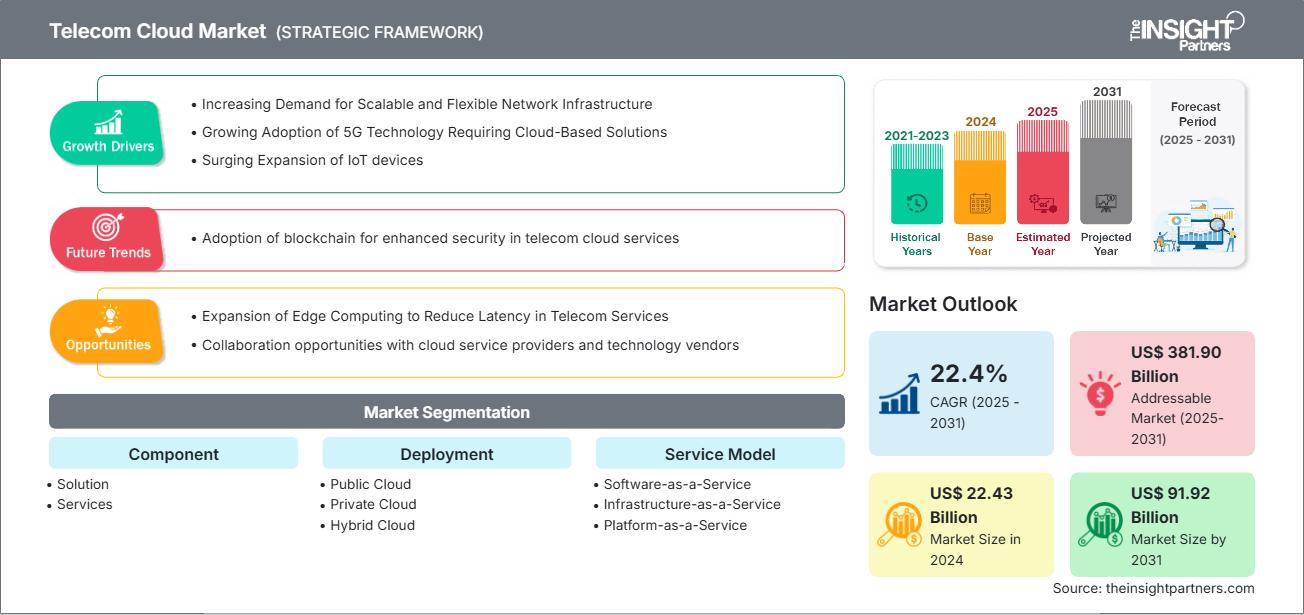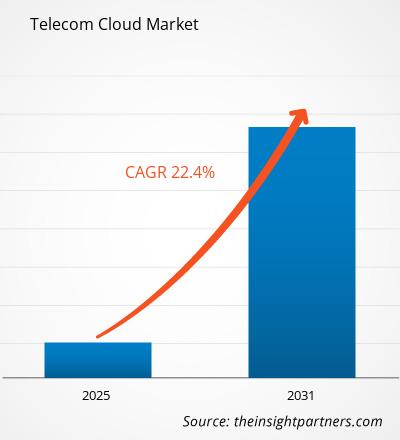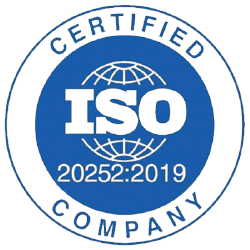The Telecom Cloud Market size is projected to reach US$ 91.92 billion by 2031 from US$ 22.43 billion in 2024. The market is expected to register a CAGR of 22.4% during 2025–2031.
Telecom Cloud Market Analysis
Telecom companies adopt cloud technologies to improve operational agility, reduce capital and operational expenditures, and accelerate service deployment. By leveraging the cloud, operators can dynamically scale resources, automate network functions, improve fault tolerance, and rapidly launch digital services such as unified communications, content delivery, and customer self-service platforms. Increasing data consumption, rising demand for remote work tools, and the growing need for seamless digital experiences increase the importance of telecom clouds. Additionally, partnerships with hyperscale cloud providers such as AWS, Microsoft Azure, Google Cloud, and Oracle are helping telecoms unlock advanced capabilities in analytics, cybersecurity, and AI. As telecom networks evolve to meet the needs of a hyperconnected world, cloud adoption is no longer optional. The telecom cloud market is poised for robust growth in the coming years, driven by increasing investment in 5G infrastructure, rising demand for real-time services, and the ongoing shift toward software-defined networking and virtualized, cloud-native systems.
Telecom Cloud Market Overview
Telecom cloud refers to the integration of cloud computing technologies into telecommunications infrastructure and services. It enables telecom operators to virtualize traditional network functions, host services and applications in cloud environments, and manage operations with greater scalability and efficiency. This shift from hardware-centric to cloud-native architectures is transforming the build, operation, and delivery of services by telecom cloud. It plays a critical role in enabling technologies such as 5G, IoT, edge computing, AI, and network slicing, while supporting digital transformation across consumer and enterprise segments.
Customize This Report To Suit Your Requirement
You will get customization on any report - free of charge - including parts of this report, or country-level analysis, Excel Data pack, as well as avail great offers and discounts for start-ups & universities
Telecom Cloud Market: Strategic Insights

- Get Top Key Market Trends of this report.This FREE sample will include data analysis, ranging from market trends to estimates and forecasts.
You will get customization on any report - free of charge - including parts of this report, or country-level analysis, Excel Data pack, as well as avail great offers and discounts for start-ups & universities
Telecom Cloud Market: Strategic Insights

- Get Top Key Market Trends of this report.This FREE sample will include data analysis, ranging from market trends to estimates and forecasts.
Telecom Cloud Market Drivers and Opportunities
Market Drivers:
- 5G Deployment and Network Modernization: Telecom operators are rapidly shifting to cloud-native architectures to support 5G capabilities, including low latency, high bandwidth, and massive IoT support. Cloud platforms enable scalable and agile infrastructure for network slicing and edge computing.
- Rising Demand for Cost-Efficient Network Operations: Cloud computing reduces capital and operational expenditures (CapEx/OpEx) by eliminating the need for extensive physical infrastructure. Virtualization and software-defined networking (SDN) enable dynamic resource allocation and efficiency.
- Increased Adoption of NFV (Network Function Virtualization): Telecom providers are virtualizing core network functions (e.g., firewalls, load balancers) to run on cloud platforms. NFV improves service agility and reduces time-to-market for new services.
- Growing Need for Scalable and Secure Communication Services: Enterprises and consumers demand high availability, mobility, and security in communication services. Cloud-native services enable quick scaling and integration with security and compliance frameworks.
- Rise in IoT and Smart Devices: Telecom cloud supports the massive data handling and analytics required for IoT ecosystems. Growth in smart homes, cities, and industries is driving cloud-enabled connectivity solutions.
Market Opportunities:
- Edge Computing Integration: Edge-cloud convergence enables real-time processing near users, vital for latency-sensitive applications like autonomous vehicles and AR/VR. Telecoms can offer new edge-as-a-service models to verticals.
- AI and Analytics-Driven Services: Embedding AI/ML in telecom clouds enables predictive maintenance, network optimization, and customer behavior analysis. Opens avenues for value-added services and personalized offerings.
- Private 5G and Hybrid Cloud Solutions: Enterprises are demanding private 5G networks powered by cloud infrastructure for secure, low-latency communications. Telecoms can offer customized hybrid cloud models combining public and private resources.
- Strategic Collaborations with Hyperscalers: Partnerships with AWS, Google Cloud, Microsoft Azure, etc., allow telecoms to leverage global cloud infrastructure and advanced services. Co-developing services enhances reach and capabilities
Telecom Cloud Market Report Segmentation Analysis
The Telecom Cloud Market is divided into different segments to give a clearer view of how it works, its growth potential, and the latest trends. Below is the standard segmentation approach used in most industry reports:
By Component:
- Solution: Telecom cloud solutions encompass software platforms for network virtualization, orchestration, and automation, enabling telecom operators to enhance agility, scalability, and operational efficiency across digital infrastructure and services.
- Services: Telecom cloud services, including consulting, integration, and managed services, support deployment and optimization, helping operators accelerate cloud adoption, reduce costs, and ensure seamless performance across hybrid and multi-cloud environments. Local
By Deployment:
- Public Cloud: Public cloud provides telecoms with scalable infrastructure and global reach, ideal for cost-efficient handling of less-sensitive workloads and rapid service innovation without heavy IT investments.
- Private Cloud: Private cloud ensures secure, dedicated infrastructure for telecoms managing critical operations, offering higher control, compliance, and performance for core network services and sensitive customer data.
- Hybrid Cloud: Hybrid cloud blends public and private cloud benefits, enabling telecoms to balance cost, control, and performance by deploying workloads across environments based on business needs and compliance.
By Service Model:
- Software-as-a-Service
- Infrastructure-as-a-Service
- Platform-as-a-Service
By Organization Size:
- SMEs
- Large Enterprises
By Geography:
- North America
- Europe
- Asia Pacific
- Latin America
- Middle East & Africa
Telecom Cloud Market Regional Insights
The regional trends and factors influencing the Telecom Cloud Market throughout the forecast period have been thoroughly explained by the analysts at The Insight Partners. This section also discusses Telecom Cloud Market segments and geography across North America, Europe, Asia Pacific, Middle East and Africa, and South and Central America.
Telecom Cloud Market Report Scope
| Report Attribute | Details |
|---|---|
| Market size in 2024 | US$ 22.43 Billion |
| Market Size by 2031 | US$ 91.92 Billion |
| Global CAGR (2025 - 2031) | 22.4% |
| Historical Data | 2021-2023 |
| Forecast period | 2025-2031 |
| Segments Covered |
By Component
|
| Regions and Countries Covered | North America
|
| Market leaders and key company profiles |
|
Telecom Cloud Market Players Density: Understanding Its Impact on Business Dynamics
The Telecom Cloud Market is growing rapidly, driven by increasing end-user demand due to factors such as evolving consumer preferences, technological advancements, and greater awareness of the product's benefits. As demand rises, businesses are expanding their offerings, innovating to meet consumer needs, and capitalizing on emerging trends, which further fuels market growth.

- Get the Telecom Cloud Market top key players overview
Telecom Cloud Market Share Analysis by Geography
In Telecom Cloud Market, North America dominated the market in 2024. The US leads with heavy investments from major cloud hyperscalers (AWS, Azure, and Google Cloud) and telecom giants such as AT&T, Verizon, and T‑Mobile. Telecom operators are building cloud‑native 5G cores, embracing hybrid/multi‑cloud strategies, and adopting network slicing, edge computing, and AI-driven automation.
The Telecom Cloud Market grows differently in each region. This is because of factors like digital technology, government rules, and others. Below is a summary of market share and trends by region:
1. North America
- Market Share: Holds a significant portion of the global market
- Key Drivers:
- Rapid rollout of 5G networks increases demand for cloud-native infrastructure.
- Early cloud adoption by telecoms and hyperscaler partnerships (e.g., with AWS, Azure).
- Rise in low-latency applications like autonomous vehicles and smart cities.
- Trends: Contactless and mobile payments are being used by a growing number of people, and payment security is becoming stronger
2. Europe
- Market Share: Substantial share due to early adoption of digital commerce
- Key Drivers:
- EU’s Digital Strategy pushes telecom cloud adoption and data sovereignty.
- Telecom cloud supports green IT and network optimization.
- Fiber and 5G rollouts need scalable and flexible cloud infrastructures.
- Trends: Rise of sovereign cloud solutions (e.g., GAIA-X project), telecoms shifting to multi-cloud and hybrid architectures, and cross-border collaboration on cloud-based network infrastructure..
3. Asia Pacific
- Market Share: Fastest-growing region with rising market share every year
- Key Drivers:
- High mobile and data usage boosts demand for scalable telecom infrastructure.
- Countries like India, China, and Southeast Asia pushing for smart cities and cloud-based telecom systems.
- Trends: Surge in telecom-hyperscaler partnerships for cloud rollouts and increased investments in AI and cloud-native BSS/OSS platforms.
4. South and Central America
- Market Share: Growing market with steady progress
- Key Drivers:
- Urban population growth fuels telecom network expansion and modernization.
- Cloud reduces CapEx/OpEx for telecom operators with budget constraints.
- Trends: Increased focus on cloud-native 5G core deployment in major economies like Brazil and Argentina.
5. Middle East and Africa
- Market Share: Although small, but growing quickly
- Key Drivers:
- Growing need for reliable, scalable networks in underserved areas.
- Cloud infrastructure is critical for smart cities across the Gulf region.
- Trends: Increased public-private partnerships for telecom infrastructure and gradual migration toward private and hybrid cloud models.
Telecom Cloud Market Players Density: Understanding Its Impact on Business Dynamics
High Market Density and Competition
Competition is strong due to the presence of established players such as AT&T Inc.; Amazon Web Services Inc; Telefonaktiebolaget LM Ericsson; Verizon Communications Inc; and International Business Machines Corp. Regional and niche providers like Mavenir (US), Athonet (Italy), IP Infusion (Japan) and are also adding to the competitive landscape across different regions.
This high level of competition urges companies to stand out by offering:
- Advanced security features
- Value-added services
- Competitive pricing models
- Strong customer support
Opportunities and Strategic Moves
- Collaborations with AWS, Microsoft Azure, Google Cloud to leverage global cloud infrastructure and accelerate telecom cloud adoption.
- Investing in open-source communities and Open RAN standards to promote interoperable cloud-native network solutions (e.g., Mavenir and Altiostar).
- Developing edge cloud, private 5G, and hybrid cloud solutions tailored for various industry verticals, including smart cities, automotive, and manufacturing.
Major Companies operating in the Telecom Cloud Market are:
- AT&T Inc.
- Amazon Web Services Inc
- Telefonaktiebolaget LM Ericsson
- Verizon Communications Inc
- International Business Machines Corp
- Cisco Systems Inc
- Broadcom Inc
- Microsoft Corp
- Google LLC
- Telstra Corp Ltd
Disclaimer: The companies listed above are not ranked in any particular order.
Other companies analysed during the course of research:
- Intellias
- NTT DATA Group Corporation
- Nokia
- Huawei Technologies Co., Ltd.
- Metaswitch Networks
- Cyfuture
- China Telecom Americas, Inc.
- Informatica Inc.
- Check Point Software Technologies Ltd
- Hewlett Packard Enterprise Development LP
- Athonet
- IP Infusion
- Mavenir
- Altiostar
- Radisys
Telecom Cloud Market News and Recent Developments
- Ericsson launched Ericsson On-Demand In June, 2025, Ericsson announced the launch of Ericsson On-Demand, a new solution delivering core network services as a true software-as-a-service (SaaS) platform to communications service providers (CSPs). The platform is designed with Google Cloud, leveraging AI infrastructure and Google Kubernetes Engine (GKE) - and is managed end-to-end by Ericsson. The solution will help CSPs to quickly set up and grow core network services, cut operating costs, and gain business flexibility with a fully managed, cloud-native platform.
- IBM launched IBM Guardium Data Security Center In August 2024, as hybrid cloud, AI, and quantum-related risks upend the traditional data security paradigm, IBM launched IBM Guardium Data Security Center, allowing organizations to protect data in any environment, throughout its full lifecycle, and with unified controls. IBM Guardium Data Security Center provides a common view of organizations' data assets, empowering security teams to integrate workflows and address data monitoring and governance, data detection and response, data and AI security posture management, and cryptography management together in a single dashboard. IBM Guardium Data Security Center includes generative AI capabilities to help generate risk summaries and boost security professionals' productivity.
Telecom Cloud Market Report Coverage and Deliverables
The "Telecom Cloud Market Size and Forecast (2021–2031)" report provides a detailed analysis of the market covering below areas:
- Telecom Cloud Market size and forecast at global, regional, and country levels for all the key market segments covered under the scope
- Telecom Cloud Market trends, as well as market dynamics such as drivers, restraints, and key opportunities
- Detailed PEST and SWOT analysis
- Telecom Cloud Market analysis covering key market trends, global and regional framework, major players, regulations, and recent market developments
- Industry landscape and competition analysis covering market concentration, heat map analysis, prominent players, and recent developments for the Telecom Cloud Market
- Detailed company profiles
Frequently Asked Questions
What are the factors driving the telecom cloud market ?
What is the expected CAGR of the Telecom Cloud Market ?
Which are the leading players operating in the Telecom Cloud Market ?
What are the future trends in the Telecom Cloud Market ?
- Historical Analysis (2 Years), Base Year, Forecast (7 Years) with CAGR
- PEST and SWOT Analysis
- Market Size Value / Volume - Global, Regional, Country
- Industry and Competitive Landscape
- Excel Dataset
Recent Reports
Testimonials
Reason to Buy
- Informed Decision-Making
- Understanding Market Dynamics
- Competitive Analysis
- Identifying Emerging Markets
- Customer Insights
- Market Forecasts
- Risk Mitigation
- Boosting Operational Efficiency
- Strategic Planning
- Investment Justification
- Tracking Industry Innovations
- Aligning with Regulatory Trends





















 Get Free Sample For
Get Free Sample For